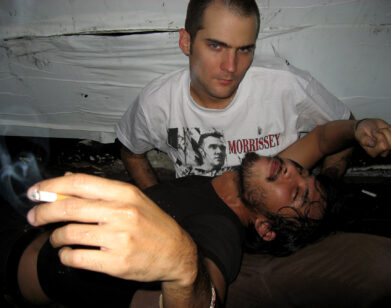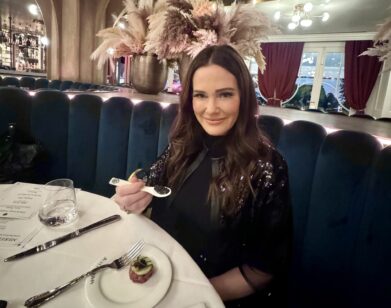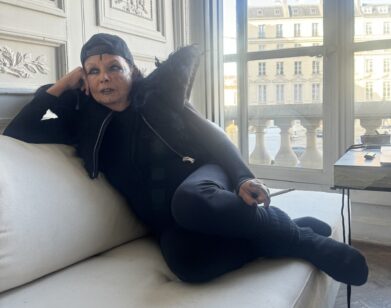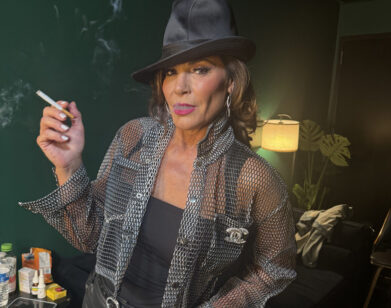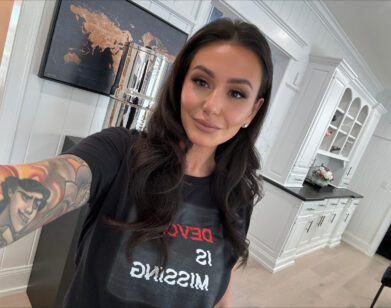Adam Goldman, on The Outs
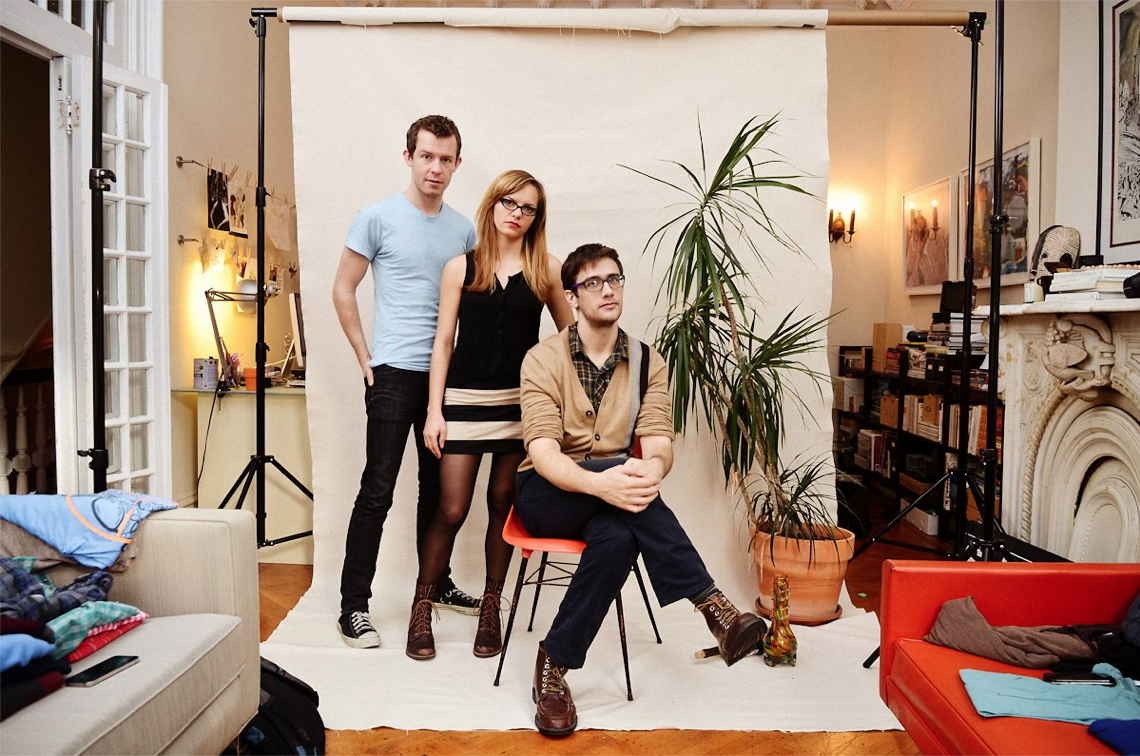
ABOVE: ADAM GOLDMAN (RIGHT) WITH HIS OUTS CASTMATES HUNTER CANNING AND SASHA WINTERS. IMAGE COURTESY OF UNUSUALLY FINE PHOTOGRAPHY
Surfing the expanse of network and cable television, it’s rare that viewers can find a truly representative depiction of the gay community. Shows like The New Normal and Modern Family might point to progress by virtue of featuring gay protagonists on primetime in the first place, but they still default to caricature and cliché. It’s no wonder, then, that the most accurate and essentially human portrayal of young gay men today can be found on the Net, not the networks. Since premiering in spring 2012, a web series called The Outs has taken the gay community by storm. It’s been praised by The Huffington Post, Out, Paper, and more for its heartfelt and realistic portrayals of a group of 20somethings as they struggle with life and love in the city. The series follows Jack (Hunter Canning) and Mitchell (Adam Goldman), six months after their tumultuous relationship comes to an end, and tackles the universally-relevant question of whether or not friendship can blossom in the loss of love.
This Thursday, January 31, the Brooklyn Museum is hosting a special screening of the series. It will feature a panel Q&A with The Outs cast, as well as a sneak preview of the seventh (and final) episode, set to premiere in March. In advance of the screening, we spoke with 27-year-old creator and star Adam Goldman about the series’ success, drawing inspiration from his own life in Brooklyn, and contrasting the show with SVU.
BENJAMIN LINDSAY: So let’s just get started here with the origin story of The Outs—how did it all begin?
ADAM GOLDMAN: My roommate, Sasha Winters, we lived with each other in college, we knew that we wanted to work on something together. And we were kind of tired of working on other people’s projects that we weren’t that passionate about, so we wanted to make our own. I had written a scene a few years ago that ended up being the last scene of the first episode of the show, where my character, Mitchell, is having a fight with his ex-boyfriend, Jack. I wrote that scene and then just sort of forgot about it for a year. And then my ex, one day, said to me—I was wearing a blue shirt, and he said, “Wow, you look really desperate in blue,” and I said, “Man, that’s a really fucked-up and rude thing to say,” and he said, “I’m quoting you; you wrote that.” I had sent him the scene. And I said, “No, I didn’t write that! You’re crazy, I would never write that.” And he sent me the scene that I had written, like, a year ago as proof. And I rediscovered that I liked the scene. The characters had different names and the situation was a little different, but I was curious about the scene that I had written and who these people were and why they had so much distaste for each other. So that was kind of the idea of the show, to develop that.
LINDSAY: And I’ve always wondered: we’ve got the origin story of The Outs, but is the series at all autobiographical to your life, or is it—?
GOLDMAN: No, it’s not. I’ve had breakups, but I’ve never had a breakup quite like this, thank God.
LINDSAY: So where do you get inspiration for the series’ plot and themes?
GOLDMAN: We just sort of found our way into them. I mean, theme-wise, there’s a relationship I’ve noticed between gay men—not exclusively gay men, but in my experience, largely between gay men, where because there are only so many fish in the pond, even in a super-gay metropolitan city like New York, if you are someone’s boyfriend or lover or whatever and then you have a falling-out with them, it’s kind of hard to sustain that sometimes. You can find yourself saying, “I like certain things about you, I like what you bring out in me, but this sexual, romantic relationship isn’t really working for us—but can we reconfigure ourselves in such a way that you can remain in my life?”
LINDSAY: What are your thoughts on the way the gay community is portrayed on other scripted television?
GOLDMAN: I mean, it’s a limited slice of life. You name gay characters on TV right now, and you’ve got Modern Family and The New Normal, and those are both shows about white gay couples in their 30s in California who are adopting. I’ve gotten quoted a lot [about that], and it almost seems like I’m anti-adoption or something, which I’m not! That doesn’t speak to me, that doesn’t speak to a lot of my friends; that’s just not the place where we are. And so I think there’s a notion in both of those to two varying extents that—I mean, I like Modern Family a lot—but that you can maybe be as fruity as you want and as femme as you want, as long as you are married to a straight-acting, football-watching, beer-chugging lawyer or doctor to balance out. I don’t think that’s the way that “gay” works—that’s not the way that relationships work. I don’t know if I want to say broadly, “More representation is good”—but, you know, there are more stories to be told, and I think that we’re just trying to fill in the blanks. Look at TV; look at all the stories about straight people. Growing up as straight person, you’ve got—sorry, you’ve got me going now—you’ve got infinite narratives about straight people and things that you can do and ways that you can grow up and jobs that you can have and lifestyles that you can have, and as a gay person growing up, you just don’t have those. You have maybe four options.
LINDSAY: Another major appeal of the series that it’s all local—it’s filmed locally, it’s all local musicians, local actors. Was keeping the production stripped down and focused in Brooklyn due to financial limitations, or did you want to pay homage to the city?
GOLDMAN: It’s a comfortable in-between. And I think that we’ve sort of—you know, I asked someone the other day, we were listening to a band and I said, “Who are these people, are they local?” And he said, “They’re local to California.” And it’s funny to just think about it in those terms. We’ve used a few bands from across the country—they’re all very indie. But for the most part it’s we’re all here in Brooklyn, surrounded by these great bands and wonderful musicians, and it would be really foolish not to take advantage of that.
LINDSAY: And how did you go about filming in Brooklyn? I know that you used a wine shop right across the street from your apartment, for instance.
GOLDMAN: Yeah, we just approached people, usually businesses that we patronized, and just said, “Hey, we’re working on this thing.” And people were generally pretty open to it, and it’s a nice bit of exposure, especially now that the community surrounding the show has grown and we’ve got 12,000 Facebook fans and when you tell someone, “We’re gonna direct people to you”—because we like to feature them, we like to feature the bands on the Facebook page—that does mean something now that it’s gonna be in front of 12,000 people globally. It’s pretty cool.
LINDSAY: Now I know that The Outs has been compared to a lot of different shows. I know you’ve heard it before, so I won’t say it, but it just won the Golden Globe for Best Comedy Series…
GOLDMAN: Uh huh, referring to Game of Thrones, of course.
LINDSAY: Of course, of course. I was curious as to how you separate yourself from series that may be covering similar territory.
GOLDMAN: I mean, we don’t strive to do that. Again, it’s just about telling the story honestly in the best, most efficient way possible. But, I mean, in that particular case, we were contemporaneous with, you know, “Game of Thrones,” and it’s like, the comparison is there, but we happened at the same time. It’s almost to the week; I think we premiered at the same time—not that our premiere was the same thing as their premiere, but in the zeitgeist, very much, and we don’t try to differentiate ourselves. Some lovely human being on Tumblr made a Venn diagram that was the things about The Outs and things about Girls, and there was the overlap, which was Brooklyn, People In Their 20s, and Sex. They’re really different shows, and I think that in terms of the way we tell stories and the stories that we tell, I think they’re totally different.
LINDSAY: Certainly. But like Girls and other series preceding it, I find that The Outs is pretty raw in its depiction of sex and language and things of that nature. Were you ever tentative to show things that others may find offensive?
GOLDMAN: Like what?
LINDSAY: Well, for instance, the anonymous sex that Jack partakes in.
GOLDMAN: It’s funny that you say that, because it’s really just the first episode.
LINDSAY: That’s right! It’s funny the scenes that stick out in my mind.
GOLDMAN: Yeah, and I get that, and that was deliberate—that’s the most explicit sex that we have, in the first 30 seconds of the show. And what it is is less than three seconds of blurred-out gyration and some moaning, right? And for some people, they watch that, and they’re like, “Whoa!” I’ve been a room with people who aren’t prepared for it, and they’re like, “Wow!” And so that was deliberate to put that up front and say, “Well if you can’t handle that, then you can’t handle the subject matter of the show, which actually has very little to do with that.” Our show is so tame compared to, I mean, turn on Law & Order: SVU. “We found her vagina in the cat’s litterbox; she’s been dismembered.” I can’t watch that.
THE BROOKLYN MUSEUM WILL HOST A SPECIAL SCREENING OF THE OUTS TOMORROW, JANUARY 31, AT 7 PM. FOR MORE ON GOLDMAN AND THE SERIES, VISIT ITS WEBSITE.

